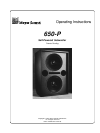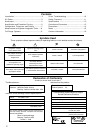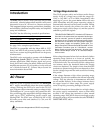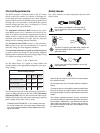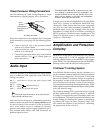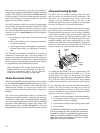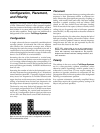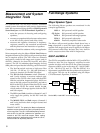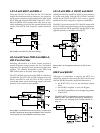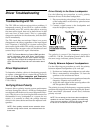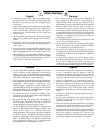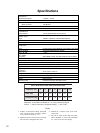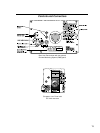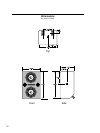
7
Configuration, Placement,
and Polarity
Designing a full-range system requires an understanding
of how subwoofers respond when grouped together,
how they interact with nearby walls and floors, and how
their location in a system affects the choice of polarity to
use for other speakers. These topics are introduced as
background for the section Full-Range Systems.
Configuration
A single subwoofer has an essentially omnidirectional
coverage pattern. A horizontal line with two adjacent
subs narrows the horizontal coverage area, without
changing the vertical coverage, compared to one sub. A
vertical stack of two subs narrows the vertical coverage
without changing the horizontal coverage. In both cases,
there is 3 to 6 dB SPL of on-axis addition.
Increasing the size of the horizontal or vertical array
from two to three subs further narrows the respective H
or V coverage without changing the corresponding V or
H coverage. Both the vertical and horizontal three-sub
arrays provide approximately 10 dB SPL addition more
than one sub.
Increasing the number of subs in the horizontal or verti-
cal array increases the corresponding H or V directional
control and the system SPL. A properly designed vertical
array steers low frequencies to include balconies and
upper tiers but avoids unnecessary interaction with the
ceiling; a horizontal array focuses low frequencies for
the longer throw distances required by large venues.
The three-by-two array (below left) narrows the H and
V coverages, and produces 10 to 15 dB SPL more than a
single sub. Combining the vertical and horizontal ar-
rays in an L-configuration (below right) provides more
on-axis SPL and directional control than the three-by-
two array.
Both the three-by-two group and L-configuration increase the
SPL and directional control.
Placement
One of the most important factors governing subwoofer
response is their placement relative to adjacent sur-
faces. Subwoofers gain significant power by coupling, or
loading, with nearby floors and walls. Half-space loading
describes a speaker coupling with one surface. Subs
placed on the floor benefit from half-space loading,
while flown subs in free-space (without a nearby wall or
ceiling) do not. In general, subs in half-space generate
twice the SPL (+6 dB) compared to the same number in
free-space.
It can be beneficial to fly subwoofers, despite the lack of
half-space loading. Placing subwoofers within a flown
cluster of mid-hi speakers creates a smooth frequency
image because the subs are not separated by the dis-
tance from the cluster to the floor.
NOTE: SPL values refer to an on-axis measurement
position. The actual SPL addition and narrowing of coverage
varies with frequency and depends on the physical
displacement between cabinets, loading conditions, and
room acoustics.
Polarity
The cabinets in the next section, Full-Range Systems,
are in a close-proximity coplanar orientation, unless
otherwise stated. Separating a mid-hi speaker from a
subwoofer by more than 5 ft may require setting the
speakers to opposite polarities to compensate for the
propagation delay from each speaker to the designated
listening or measurement position.
In a coplanar orientation, externally amplified Meyer
subwoofers require the opposite polarity setting to all
Meyer self-powered speakers.



